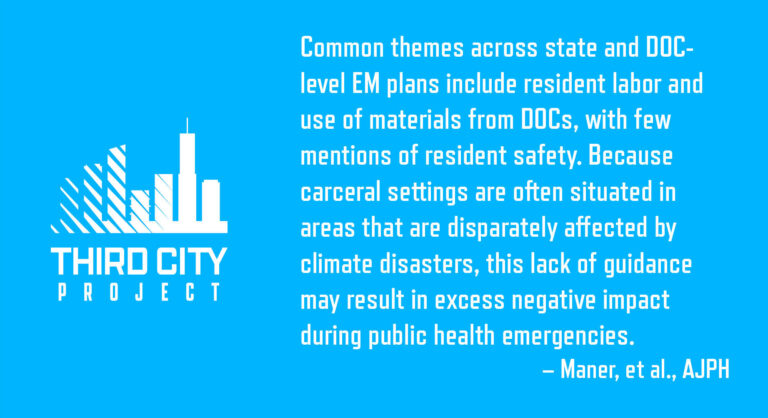
Climate change is here to stay. The frequency and intensity of climate events, including hurricanes, floods, wildfires, and extreme heat, will continue to increase in the future. While all individuals are vulnerable to these disasters, health equity demands addressing the unique challenges of those in prisons. Prisons require special attention and planning in climate mitigation and disaster response planning. The construction of prisons in under-resourced communities, a practice known as prison gerrymandering, has made prisons particularly susceptible to the effects of climate disasters. In Texas, Louisiana, and Florida, for example, prisons have been flooded following hurricanes, leading to health and safety concerns for prison residents and the surrounding areas.
Despite the increasing frequency and severity of climate disasters, many emergency management plans do not include consideration of incarcerated people. State emergency management plans are typically comprehensive, multi-agency documents that determine how a state government will respond to large-scale crises. Departments of Correction are often included in these plans, generally in reference to the role carceral staff will play in the response–for instance, transportation of and logistics for disaster response teams. When incarcerated people are mentioned in state emergency plans, it is almost exclusively as a source of labor in disaster mitigation and recovery efforts rather than as individuals with unique needs and vulnerabilities. While some places have made some strides in addressing the issue, including California’s SB2147, which helps formerly-incarcerated firefighters to find work, much more needs to be done to protect the health and safety of those currently in prison.
DOC emergency plans are analogous to state emergency management plans. They are intended to codify how an agency responds to a disaster or crisis. Unlike state emergency plans, however, these agency documents focus almost exclusively on man-made fires, riots, and escapes. By focusing on possible threats arising from the confined population, DOCs are overlooking the risk posed by climate change. By failing to anticipate and address preventable tragedies, carceral administrators are setting the stage for the very kind of disruptive behaviors they are trying to plan for–a cycle as predictable as it is dehumanizing.
To address these challenges, there needs to be comprehensive inclusion of incarcerated individuals in federal guidance on emergency management, as well as an overhaul of DOC emergency management plans. Without these measures, the healthcare system will face an increased burden, and disparities in health outcomes for incarcerated individuals will likely worsen. Mortality and morbidity rates in prisons are likely to increase as climate disasters become more frequent and severe.
Comprehensive planning for the emergent threats posed by climate change is possible with dedicated effort. To learn more about this issue and to see what other countries have begun to implement these measures to protect incarcerated individuals check out our publication, Where Do You Go When Your Prison Cell Floods.


